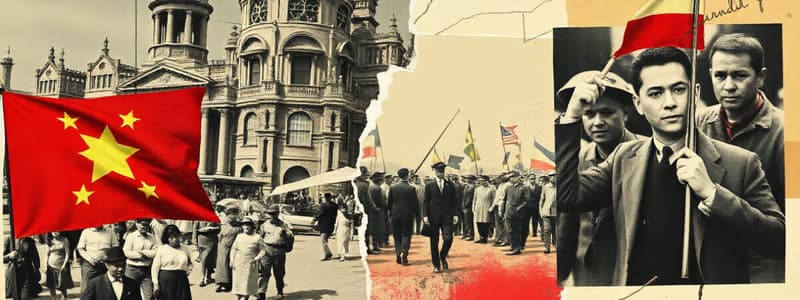Podcast
Questions and Answers
Spanish rule in the Philippines lasted for over 300 years.
Spanish rule in the Philippines lasted for over 300 years.
True (A)
The Galleon Trade connected Manila and Tokyo.
The Galleon Trade connected Manila and Tokyo.
False (B)
Catholicism became the dominant religion in the Philippines during Spanish rule.
Catholicism became the dominant religion in the Philippines during Spanish rule.
True (A)
The Katipunan was a secret society that opposed American rule.
The Katipunan was a secret society that opposed American rule.
The Philippine Revolution was marked by the successful expulsion of Spanish troops.
The Philippine Revolution was marked by the successful expulsion of Spanish troops.
English was established as the language of instruction during the Spanish Colonial Period.
English was established as the language of instruction during the Spanish Colonial Period.
The desire for self-governance was a key motivation for Filipinos during the Philippine-American War.
The desire for self-governance was a key motivation for Filipinos during the Philippine-American War.
Key figures of the Philippine Revolution included José Rizal and Manuel L. Quezon.
Key figures of the Philippine Revolution included José Rizal and Manuel L. Quezon.
The transition from Spanish to American rule was smooth and without challenges.
The transition from Spanish to American rule was smooth and without challenges.
The introduction of Spanish language and culture influenced Filipino languages.
The introduction of Spanish language and culture influenced Filipino languages.
Flashcards
Spanish Colonial Period
Spanish Colonial Period
The Spanish colonization of the Philippines, lasting over 300 years, from the 16th century. It changed Filipino culture, society, and religion, introducing Catholicism and a complex social hierarchy.
Philippine Revolution
Philippine Revolution
A period of armed struggle by Filipinos seeking independence from Spanish rule, ultimately culminating in a declaration of independence.
American Colonial Period
American Colonial Period
Following the Spanish-American War, the US took control of the Philippines. This period saw the introduction of English and educational reforms alongside the US's strong military presence.
Philippine-American War
Philippine-American War
Signup and view all the flashcards
Spanish-American War
Spanish-American War
Signup and view all the flashcards
Galleon Trade
Galleon Trade
Signup and view all the flashcards
Katipunan
Katipunan
Signup and view all the flashcards
Andrés Bonifacio
Andrés Bonifacio
Signup and view all the flashcards
Emilio Aguinaldo
Emilio Aguinaldo
Signup and view all the flashcards
Manila
Manila
Signup and view all the flashcards
Study Notes
Spanish Colonial Period
- The Spanish colonized the Philippines in the 16th century, establishing Manila as a major trading port.
- Spanish rule lasted for over 300 years, significantly impacting Filipino culture, society, and religion.
- Spanish authorities introduced Catholicism, which became the dominant religion.
- A complex social hierarchy formed, with Spaniards at the top and Filipinos at the bottom.
- Spanish colonization brought modernization in some aspects like infrastructure and education.
- Introduction of the Spanish language and culture influenced Filipino languages.
- The Galleon Trade, connecting Manila and Acapulco, Mexico, was a pivotal aspect of the colonial economy.
Philippine Revolution
- Growing discontent among Filipinos towards Spanish rule led to several pre-revolutionary movements.
- The desire for independence and self-governance fueled the revolution.
- The Katipunan, a secret society, played a crucial role in advocating for independence through armed rebellion.
- Key figures like Andrés Bonifacio and Emilio Aguinaldo led the revolutionary movement.
- The Philippine Revolution, although initially successful in driving out Spanish troops, was faced with subsequent challenges, such as the establishment of a new colonial power.
- The revolution lasted for several years, culminating in the declaration of Philippine independence.
American Colonial Period
- The Philippines became an American territory following the Spanish-American War.
- The United States established military bases and maintained control over the islands.
- The transition from Spanish to American rule brought new challenges and adjustments in governance and culture.
- The US maintained a strong military and economic presence in the Philippines.
- Educational reforms were introduced, including the establishment of English as the language of instruction.
- American influence was also witnessed in infrastructure and the development of the country's economy, albeit with limitations.
- The Filipinos were initially subjected to American rule, and the shift in power was not smooth.
Philippine-American War
- The Philippine-American War followed the declaration of Philippine independence, marked by armed conflict.
- The war was a result of Filipino resistance to American colonial rule.
- The war resulted in significant loss of life and suffering on both sides.
- The desire for full independence and self-governance remained a driving force for Filipinos.
- The war eventually concluded in victory for the Americans and continued US control.
- Filipinos experienced conflict, losses, and struggle as they fought for freedom from colonial powers.
- The struggle brought challenges towards Philippine independence.
Commonwealth Period
- The Commonwealth period established a transition towards self-governance in preparation for full independence.
- The period saw the establishment of a Philippine government with significant autonomy in governance.
- It aimed to gradually build the capacities of Filipinos for future self-governance and administration.
- The period aimed to equip and train Filipinos for self-rule and administration of the government.
- The Commonwealth period provided opportunity to prepare for responsible self-governance.
Studying That Suits You
Use AI to generate personalized quizzes and flashcards to suit your learning preferences.




